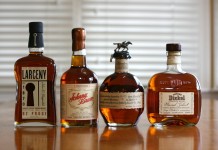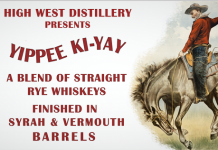
Buffalo Trace is home to some of the best bourbon in the world, and each year they release a showcase series under the Buffalo Trace Antique Collection. These whiskeys are are all priced at $80 even though they span a wide range of ages and proofs, and are often incredibly hard to find. The Antique Collection hits store shelves sometime between mid-September and October and is often quickly snapped up. Buffalo Trace deserves a lot of credit when it comes to moving the needle for American Whiskey: the company’s Blanton’s Single Barrel Bourbon was the first single barrel American Whiskey released, and their whiskey stocks are the base for some of the world’s most sought after spirits (including Pappy Van Winkle).
This year, the Buffalo Trace Antique Collection is comprised of five whiskeys: George T. Stagg, William Larue Weller, Thomas Handy, Eagle Rare 17, and Sazerac 18. Instead of reviewing these whiskeys individually, we’ve decided to review them together in this one master review. We’re also doing something that many whiskey enthusiasts have asked us to do – giving them scores. Please let us know in the comments if scores likes these are something you’d like to see us do more. It’s a complex issue and we’ve shied away from them in the past.
George T. Stagg Kentucky Straight Bourbon Whiskey (60.05% ABV / 138.1 proof, $80) – when someone asks which whiskey has made the biggest impression on us, the answer is always George T. Stagg. We’ll never forget the first time we had this whiskey and the fireworks that it produced. There are few whiskeys in the world with the sheer power of flavor that George T. Stagg produces. Last year, Buffalo Trace tried to make Stagg something that is more commonly available with Stagg Jr., but there’s simply no substitute for the real thing.
The 2014 George T. Stagg comes from Buffalo Trace’s warehouses C, H, I, K, L, P, and Q, and was distilled back in the spring of 1998 (making it ostensively a 16 year old whiskey). Buffalo Trace informs us that there will be more George T. Stagg on the market this year than last year. In 1997 they increased distillation for Stagg, which is good news, but the demand this year will undoubtedly be even higher than last, so it’ll still be a hot ticket to get.
The nose for the 2014 George T. Stagg is pretty oak forward with a slight varnished wood note along with old oak furniture. Beyond the oak is cinnamon, marzipan, coconut, and caramel. You can tell from the nose that this whiskey has some real power but the nose isn’t assaultive, just big. As always Stagg is a power punch right out of the gate, with the entry combining caramel, cinnamon, and monster oak.
Everything here is turned up to 11 – the caramel is lush, cinnamon spicy, and the oak strong. This year’s Stagg isn’t the smack across the face that some of the previous years have been, but more lush and round than previous years. The midpalate captures Stagg’s fire and it’s here where you’re getting the real impact of the 138 proof whiskey. Through much of the midpalate, Stagg manages to keep the caramel-cinnamon-oak balance, but things teeter at the end of the midpalate and come crashing down on the side of the oak. The finish is long and spotlights charred oak, overly tannic and slightly bitter – a slight left turn for an otherwise solid whiskey.
George T. Stagg is the archetypal power whiskey, and Buffalo Trace has again delivered another expression of George T. Stagg in that style. In many ways it’s a little bit of a head fake before the knock out punch. The entry is really good and we really like the integration between the strong flavors, but the end of the midpalate and the finish are over oaked. With so many other big oak releases out there, it may be what people are coming to expect, but it could have been handled with a little more finesse. Then again, Stagg is always more power than finesse. A solid, but imperfect release that will appease Stagg fans, but fall short of winning a ton of awards. 91 points.
William Larue Weller Kentucky Straight Bourbon Whiskey (70.1% ABV / 140.2 proof, $80) – this year’s offering was distilled in the spring of 2002, making it a 12 year wheated old bourbon. This year’s release was aged on the second, third, fourth, and sixth floors of Warehouses D and K, and weighing in at 140.2 proof, it’s the strongest Weller release yet.
Whereas the George T. Stagg lead with oak and caramel, the William Larue Weller is much more acidic in the nose with orange peel, dried wheat, and dried apricot making up the core of the nose. Underneath are almonds, toffee, and dusty oak. The entry for William Larue Weller is not shy about showing off the monster proof here. It’s much stronger out of the gate than this year’s George T. Stagg, but like Stagg there’s a sense of lush caramel right from the start. The entry for William Larue Weller is really engaging and manages to be both sweet and spicy, and slightly acidic. The transition from opening to midpalate is seamless as the flavors introduced in the entry progressively build. In the midpalate things get a little more spicy with cinnamon, clove, and oak accompanied by Wheaties, blackberry, and caramel. At the end of the midpalate there’s a real wallop from the alcohol – it’s big, bold, and impressive, but doesn’t take you out of the experience.
The opening and midpalate set the stage for William Larue Weller’s crescendo, and when it comes, it’s really spectacular. The finish is, of course, dry, defined greatly in part by the alcohol blast at the end of the midpalate, and accompanied by toffee and sweet charred oak. The William Larue Weller takes water extremely well – a few drops intensifies the lushness of the whiskey.
Good whiskey has the ability to take you on a journey, and this year’s William Larue Weller does just that. It’s a more complete whiskey than this year’s George T. Stagg and ultimately a much better one. 95 points.
Thomas H. Handy Sazerac Rye (64.4% ABV / 129.2 proof, $80) – along with George T. Stagg, Thomas H. Handy has always been one of the all-stars of the Buffalo Trace Antique Collection. There are few rye whiskeys on the market that are as big and bold as Handy. This year’s Handy was distilled in the spring of 2008, making it a 6 year old rye whiskey. The 6 year age is a bit of a sweet spot for rye whiskey, the same point that the grandmaster, Jimmy Russell, bottled his Russell’s Reserve. The 2014 release was aged on the fifth floor of Warehouse M.
From the first nosing it’s clear that this year’s Thomas H. Handy isn’t in the same universe as previous years’ releases. After a vapor shot, an odd vegetal note emerges – okra?!? Yes, okra (it’s not a note we’ve gotten from a whiskey in the past). Beyond that slightly off-putting note are some of the traditional rye whiskey notes like rye spice, caramel, cinnamon, and oak. There’s really no other way to put it, other than saying the nose for this year’s Handy is just odd. Fortunately, the vegetal note that was so apparent in the nose isn’t as dominant on the palate, but what is dominant is the oak. The experience of the opening is like chewing on a caramel covered pencil, lead and all. In the midpalate we get to spit the proverbial pencil out of our mouth and we get cinnamon, marzipan, and rye spice, but the opening is so off-putting that there’s nothing that follows that can fully redeem it. The finish is fairly long with a fair bit of heat that carries the cinnamon spice from the midpalate along with the rye and a dash of caramel. The overbearing wood is there, too, and it ultimately carries things to a bitter oak end.
Thomas H. Handy Sazerac Rye strongly benefits from adding water, which helps reduce some of the impact of the leaded pencil in the midpalate and enhances the caramel and cinnamon notes. Even with water the core issues are there, and the finish is still as heavy oak, fiery and bitter.
While Thomas H. Handy isn’t horrid, it’s not in line with the standard that Buffalo Trace has set for this brand. For us, this will be the benchmark whiskey in this collection for reviews. Read a review that raves about this misfire and you know that the reviewer may be rating the label more than the whiskey in the bottle. 83 points.
Eagle Rare 17 Year Old Kentucky Straight Bourbon Whiskey (45% ABV / 90 proof, $80) – Eagle Rare has always been an unsung hero of Buffalo Trace’s line, often underpriced and overlooked. It’s a little bit of a head scratcher that a 90 proof Eagle Rare is priced at the same price point as a 138 proof 16 year old Stagg and a 12 year old 140 proof Larue Willer. Perhaps Buffalo Trace has finally recognized the value of this brand and priced it accordingly. The 2014 edition was aged on the second, third, and sixth floors of Warehouses I and K.
The nose on this year’s Eagle Rare 17 year old leads with brown sugar and marzipan along with oak, orange peel, and cinnamon. The entry for Eagle Rare 17 is tightly integrated right from the start with cinnamon, brown sugar, and oak all perfectly entwined. The balance, integration, and presentation of flavors is exquisite and accompanied by a particularly pleasant mouthfeel. As we head toward the midpalate the oak spice ramps up, but it doesn’t steal the spotlight from the other flavor notes, especially the brown sugar and cinnamon, which do a great job of supporting the oak spice. The finish is long and slightly dry, driven by the oak, but again supported by the other flavors in the equation. The finish also has a slight coffee bean note added to the mix.
This year’s Eagle Rare release (like many of the other entries in the Eagle Rare line) proves that great whiskey doesn’t have to be so difficult: capture some nice flavors with balance, integration, a nice mouthfeel, and a good finish, and you’ve got a recipe for success. Eagle Rare continues its line of success with another standout release in this year’s collection. 93 points.
Sazerac Rye 18 Year Old Kentucky Straight Rye Whiskey (45% ABV / 90 proof, $80) – the nose on the Sazerac Rye is what we would have expected with the Thomas H. Handy. Rye grain leaps out of the glass along with clove, oak, ginger, mint, and caramel. The entry for Sazerac Rye is soft and round, capturing almost identically the aromas from the nose and presenting them as flavors on the palate, including rye spice, ginger, oak, mint, cinnamon, black pepper, and caramel. These flavors increase in the midpalate, but unlike the Eagle Rare they don’t lose the balance or integration established in the opening. Part of this is the sweet base of caramel and molasses which supports the rye, oak, cinnamon, ginger, clove, and black pepper spice. There’s a bit of an oak kick at the end of the midpalate with a touch of heat, but it fits well within the mix of flavors and helps give the Sazerac Rye some nice structure. Unlike this year’s Eagle Rare 17, the proofing for this year’s Sazerac Rye is spot on, balancing the flavors and heat perfectly.
The finish for the Sazerac Rye 18 is extremely long and fairly dry with the oak and rye spice at its core and the mint hovering right above. The mint and rye spice on the palate lingers around for a very long time after the whiskey has come and gone. Sazerac Rye 18 is one of the most balanced and integrated whiskeys in this year’s collection. It’s not as stand-out spectacular as the William Larue Weller, but it’s much better than this year’s Thomas H. Handy, and ultimately it is very well-crafted whiskey. 92 points.
Most years, George T. Stagg and Thomas H. Handy are the stars of this collection, but this year the underdogs William Larue Weller, Eagle Rare 17, and Sazerac 18 are the real stars of the show. The biggest disappointment is, of course, Thomas H. Handy – it’s unclear what went wrong with this batch, but the hard truth is that not all years of whiskey are good years, and that is especially true with Handy. The pricing for the collection seems a little unbalanced, as well. It’s hard to understand how Buffalo Trace is selling a 138 proof 16 year whiskey at the same price ($80) as a 6 year old rye, and yet again at the same price as a 90 proof Eagle Rare, but given the price that like spirits are hitting the marketplace lately, it makes some of these older, stronger releases a “deal”. The problem, though, is that age and proof chasers won’t be as happy as those who cherry pick this collection. Nit picks aside, Buffalo Trace has again presented some very fine whiskeys in a collection that shows their real range and capabilities.
















